
Protecting bats at risk
La Mauricie National Park
Bats play an essential role in maintaining ecological balance by controlling insect populations. However, they face many threats such as an invasive exotic disease called white-nose syndrome and habitat loss associated with the refurbishment of buildings used as maternity roosts or hibernacula.
La Mauricie National Park's conservation team is working with other Parks Canada administered sites in Quebec: Fort Lennox National Historic Site, Forillon National Park, Mingan Archipelago National Park Reserve and Grosse Île and the Irish Memorial National Historic Site to protect three bat species designated as "endangered" under Schedule 1 of the Species at Risk Act (Canada) and "threatened" under the Act respecting threatened or vulnerable species (Quebec): little brown bat, northern long-eared bat and tricolored bat. Populations of these species have been in decline since the arrival of white-nose syndrome in Quebec in 2010, a fungal infection that strikes bats during the hibernation period. Bat populations in La Mauricie National Park, once abundant and diverse, are also declining.
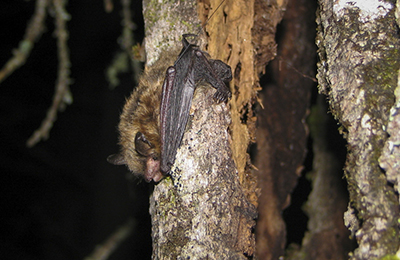

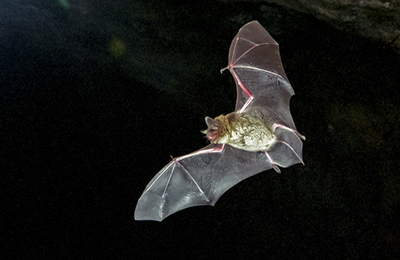
Transcript
[Parks Canada beaver logo][Parks Canada scientists walk through forest and tall grass in Forillon National Park wearing their dark green Parks Canada uniforms.] [Antoine speaks directly into the camera while, in the background, his colleague observes a building through binoculars.] My name is Antoine Plouffe Leboeuf.
[Name Tag] Antoine Plouffe Leboeuf, Ecosystem Scientist, Forillon National Park.
I’m an ecosystem scientist at Forillon National Park and I’m going to talk to you about our bat conservation work.
[Title] Field Notes: Bats, an Ally Worth Protecting.
[Antoine stands amid tall grass and speaks to the camera while two other Parks Canada staff members set up research equipment behind him.]
Today, we’re in the field to install ultrasound recorders, in order to measure bat activity in Forillon National Park.
[Parks Canada scientists, Steve and Michaël, stand amongst tall grass while setting up their sound recording equipment.]
[A timelapse depicts Parks Canada employees installing sound recording equipment in a forest near a stream. The pole is inserted into the ground so the pole stands vertically, with a square sound recording device attached to it.]
So, bats emit sounds that are inaudible to the human ear,
but we can measure them with specialized devices.
[Steve crouches on the ground to get a better look at the screen of the sound recording device.]
To be able to measure the activity rate in our park,
we placed our devices near feeding sites.
[The camera flies over a nearby stream in the forest.]
Bats feed mostly on insects and so it's good to place the stations
near streams, marshes and ponds......places where there are a lot of insects.
[With the sound recording device set up, the Parks Canada employees hike out of the research site.]
[Text] In Canada, bats play an essential role in maintaining ecological balance by controlling insect populations.
[Text] Parks Canada is part of a dynamic community of bat researchers across Canada.
[Text] We work with private landowners, universities and other conservation organizations to better understand and protect bats.
To protect species like bats,
it takes a group effort, so at Parks Canada we started a great collaboration
[Two Parks Canada scientists stand at the end of a dock in La Mauricie National Park.]
[Location Tag] La Mauricie National Park
with La Mauricie National Park,
[Two Parks Canada scientists are installing sound recording equipment near the coast in Mingan Archipelago National Park Reserve]
[Location Tag] Mingan Archipelago National Park Reserve
Mingan Archipelago National Park Reserve
[Three Parks Canada scientists stand next to a sound recording device in a forest in Forillon National Park.]
[Location Tag] Forillon National Park
and with us, Forillon National Park, to work on bat conservation and more specifically
[A photo of a Little Brown Bat hanging in a cave.]
[Text] Little Brown Bat
on three bats at risk: the Little Brown Bat,
[A photo of a Northern Bat on a researcher’s gloved hand]
[Text] Northern Bat
the Northern Bat and the Eastern Pipistrelle.
A photo of an Eastern Pipistrelle bat hanging from the ceiling in a cave.
[Text] Eastern Pipistrelle
The photo zooms into the face of the Eastern Pipistrelle, revealing a white fungus on the bat.
[Text] In Canada, the main threats to bats are habitat loss and a fungal disease called white-nose syndrome
[Label] Fungus (Evidence of white-nose syndrome)
[Text] Our goal is to help restore bat populations by protecting hibernation sites, maternities and shelters.
We are also tracking the progression of white-nose syndrome.
[Label ] Bat shelter
[Antoine speaks into the camera while, behind him, his colleague uses binoculars to observe a building that has a bat roost in the attic.]
[Location Tag] Forillon National Park
We’ve conducted twilight inventories by observing our buildings
to check for the presence of bats.
[An old white building that the scientists are observing for bat activity sits on the ocean shore while the sun sets in the distance.]
We do that just before sunset because now is the time that bats usually choose to go out hunting at night.
[Two Parks Canada scientists, Josée and Valérie, observe a heated bat nest box for signs of bats.]
[Label] Heated nest box
[Name Tag] Josée Blier, Resource Management Officer, La Mauricie National Park
[Name Tag] Valérie Turcotte-Blais, Resource Management Technician, La Mauricie National Park
[Location Tag] La Mauricie National Park
So we have binoculars, then we observe the potential exits to possibly find our famous bats.
[Text] Like in Forillon, other Parks Canada sites in Quebec regularly look for, listen to and monitor bats.
[Josée approaches a log cabin and puts her ear up to the outside wall, listening for bat movement inside.]
[Location Tag] Mingan Archipelago National Park Reserve
[Parks Canada scientists at Mingan Archipelago National Park Reserve install a sound recording device near the shore.]
This evening, we’re doing mobile inventories of bats.
[Parks Canada scientists in La Mauricie National Park prepare a vehicle to do acoustic surveys by mounting a microphone onto a pole and attaching it to the outside of the vehicle.]
[Location Tag] La Mauricie National Park
To do this, we attach a microphone to a pole that we will have outside the vehicle, then we will drive on a road which crosses the park.
[Antoine speaks into the camera while, behind him, a Parks Canada staff member attaches a microphone on a long pole to a Parks Canada truck.]
[Location Tag] Forillon National Park
[A Parks Canada truck drives by in the dark with its headlights on and the microphone attached to the vehicle’s hood.]
It will allow us to document all the bats encountered that will be detected by our recorder.
[A Parks Canada scientist sits in the front seat of the vehicle in the dark with a laptop open, recording the ultrasonic bat noises that the microphone is picking up.]
Then this inventory gives us an idea of the relative abundance of bats found in the park.
[Antoine and another Parks Canada staff member hike through tall grass into a forest to retrieve the recording device that they installed days earlier.]
So today we came to take down the station, the fixed recorder.
It's been ten nights that the device has been taking recordings of bats and we think we’re going to have lots of recordings because the temperature was good.
[Name Tag] Marie-Soleil Pétrin, Resource Conservation Officer, Mingan Archipelago National Park Reserve
[Name Tag] Adam Desjardins, Resource Conservation Officer, Mingan Archipelago National Park Reserve
[Location Tag] Mingan Archipelago National Park Reserve
[Parks Canada scientists, Marie-Soleil and Adam, hike in to retrieve the sound recorder that has been placed at Mingan Archipelago National Park Reserve.]
It's been hot, there's been no rain and then the winds were still relatively weak.
So the conditions have been ideal for having bats on our site.
[Scientists at both Mingan Archipelago National Park Reserve and Forillon National Park remove the SD memory cards from the recording devices so the recordings can be analyzed.]
And so today, we take down the station and we can go look at our recording data which will be on an SD card.
We will be able to analyze it using special software afterward.
[A Parks Canada scientist from La Mauricie National Park analyzes a bat sound recording on her computer. A graphic appears in the top left corner that shows the sound waves of the bat echolocation.]
[Label] A sound clip of a bat using echolocation to find food. The clip has been slowed down to be audible to the human ear.
[Antoine speaks directly into the camera, while kneeling in the forest where the sound recording device was placed.]
So by working together and also by working with other conservation organizations of North America,
we increase our chances of success to protect this species.
[A Parks Canada employee sits inside a vehicle at La Mauricie National Park, analyzing bat recordings on their computer.]
[Parks Canada scientists in Mingan Archipelago National Park Reserve return to their boat, anchored on the coast, so they can head back to the mainland after retrieving the bat recording data.]
[A drone flies over Parks Canada staff who are working at a bat monitoring site in a remote location in Mingan Archipelago National Park Reserve.]
[Text] Learn more about bat conservation at Parks Canada: parkscanada.gc.ca/canada-bats
[End screen directing viewers to related videos.]
Parks Canada logo
Canada wordmark
Watching and listening for bats
To help protect and restore bat populations and their habitats, in 2015 La Mauricie National Park's conservation team implemented a monitoring plan and recovery measures found in the Multi-species Action Plan for La Mauricie National Park and National Historic Sites of La Mauricie and Western Quebec regions and in the Bat Conservation Plan, currently under development.
Each year, the conservation team conducts an inventory of bat populations and habitats within the park to identify species, their level of activity (which can give an indication of their abundance) and their location. To find their way in the dark and capture their prey, bats use echolocation, i.e., they emit ultrasounds that bounce off their surroundings. The park team can track bat populations as they feed at night, using the Anabat ultrasound detector to convert, amplify and record the signal. Each species produces ultrasounds that distinguish them from others by their frequency, duration and structure. It is possible to identify the species found in the park by means of the characteristics of the recorded ultrasound.
Text transcript
[ ultrasounds ] Echolocation call of a bat recorded with an ultrasound detector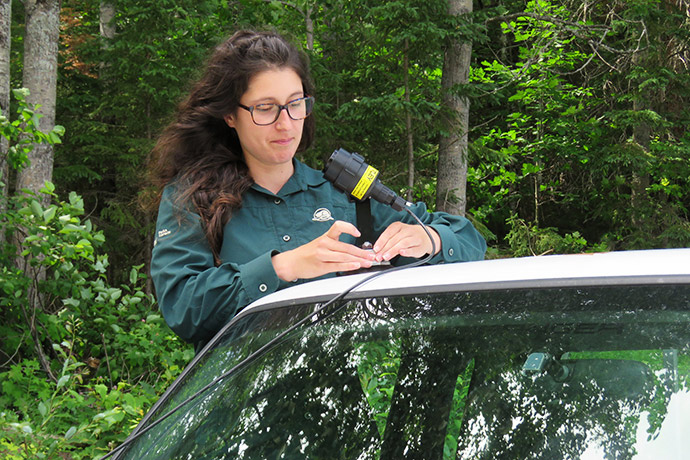

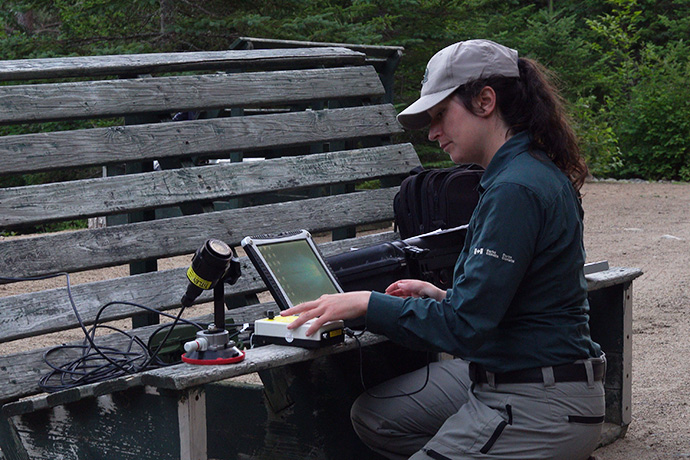
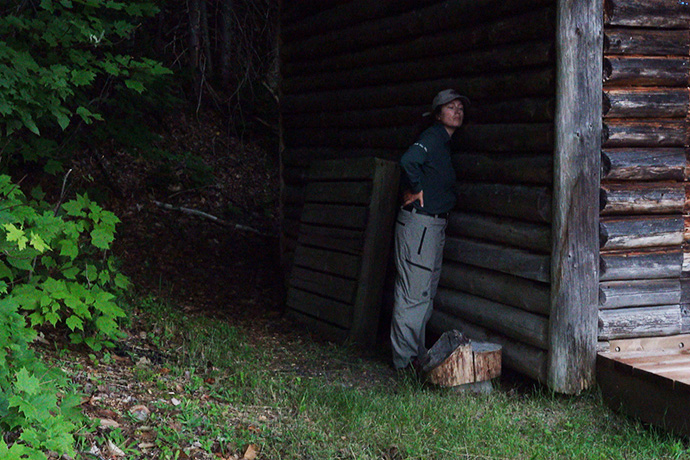
The team also monitors bat populations in the backcountry by installing devices that record bat echolocation calls in environments where they are likely to be present.
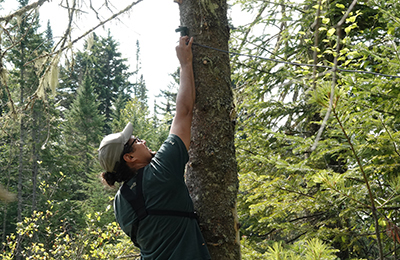
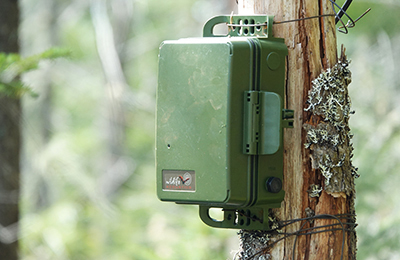
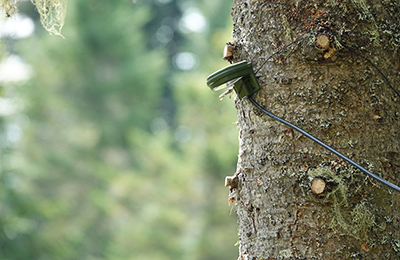
The data collected during the inventories enable the conservation team to better understand the bats and protect the areas they frequent in the park, including a building used as a maternity roost, where breeding females give birth and nurse their newborns.
The team also installed heated shelters near the Chalet Wabenaki on Domaine Wabenaki-Andrew, to compensate for the loss of bat habitat and ensure harmonious cohabitation between humans and bats, as the latter tend to take refuge in buildings. The team monitors the use of these shelters, which are occasionally visited by bats.
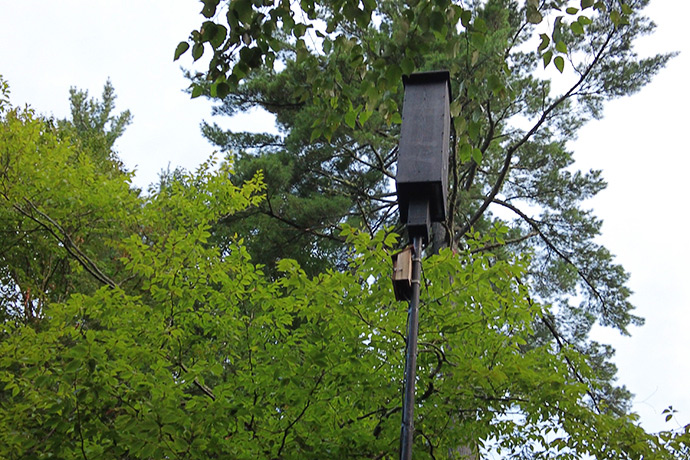
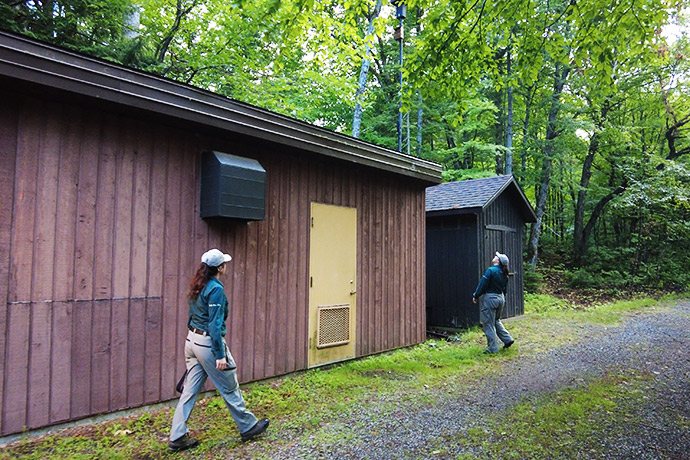
Get involved!
Here are a few ways you can help protect bats. You can:
- report your sightings to the park reception centres or entry and campground kiosks, as well as on the batwatch.ca and iNaturalist websites.
- check your equipment (camper, trailer, truck, parasol, etc.) before leaving the park to see if bats have hidden in small spaces. If they don't go away on their own, gently nudge them with a broom (not your bare hands) to avoid transporting them and spreading white-nose syndrome.
- take part in the Bats listening! activity with naturalists (summer season).
- keep up to date on the park's Facebook page.
- avoid entering caves or other areas where bats may be hibernating (winter season).
- set up a bat house.
To learn more
Quiz One, two, three: bats! (in French only)
- Date modified :